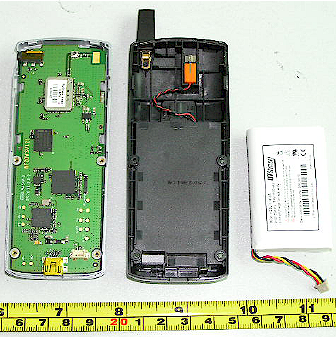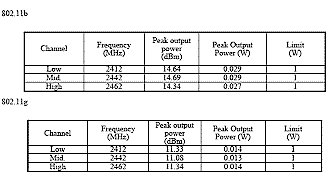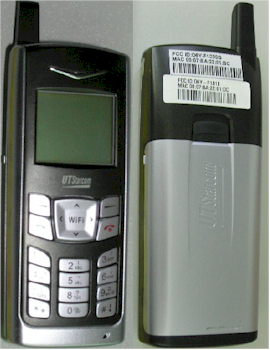Introduction
It appears the UTStarcom, which will next month begin supplying its 802.11b F-1000 Wi-Fi handset to Vonage [reviewed here], has an 802.11g version in the works. This phone breaks ranks with the current crop of VoWLAN or WiSIP phones, which all use the older 802.11b WLAN standard.
While 11b has plenty of speed to support the 100kbps or so bandwidth requirements of a VoIP phone, the use of an 11b device on a an 11g WLAN causes general throughput degradation for all clients on the AP that the device associates with. This isn’t a problem with the phone itself, but due to the way that 11g has to accommodate slower 11b devices.
Figure 1: F1000G Front and Back view
(click image to enlarge)
The aptly-named F1000G (Figure 1) looks essentially the same as the F1000, and a glance at the manual posted at the FCC website reveals essentially the same feature set. Unfortunately, the F1000G’s feature set still supports only 64 and 128 bit WEP wireless encryption, instead of the more secure WPA and WPA2. Once again, the fact that only WEP is supported isn’t really a problem for the phone. But the network it connects to will be forced to use WEP, which can be easily cracked.
Inside Story
Figure 2 shows the opened phone, which has reduced component count from the F1000.

Figure 2: F1000G opened
(click image to enlarge)
Figure 3 shows a closer view of the main board back, where you can see that the 11g radio module comes from SyChip, instead of Agere, which supplies the F1000’s 11b radio.
Figure 3: Main board back
(click image to enlarge)
The WLAN6100 module (PDF link) itself actually does support WPA2, WPA, WEP, 802.1x, LEAP and AES security, so we can hope that at some point UTStarcom will upgrade the phone to also support these more secure modes.

Figure 4: Maximum transmit power
The WLAN6100’s spec sheet lists “+15dBm RF power”, but the FCC test report excerpt shown in Figure 4 shows that’s only for 802.11b operation. 802.11g peak output power is about half that – around +11dBm / 14mW.
Figure 4: Main board front
(click image to enlarge)
Figure 4 shows the board’s front, where the mic, speaker, monochrome display and keypad are mounted.
Since the FCC certification is completed, I’d like to see Vonage set the right example and ship the F1000G instead of the F1000. While it won’t currently solve the WEP insecurity problems, the F1000G would at least not force WLANs to slow to accomodate it like the F1000 will.
But so far there’s no sign of who will be the first to make this small step toward a better VoWLAN solution available.



